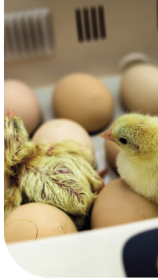Content available at:
Español (Spanish) العربية (Arabic)

There are certain practices to increase hatchability in incubation that, in most cases, do not improve the quality of the chick and, in fact, often reduce the quality of that neonate in a proven way.
Thus, in ovo vaccination plays an important role in the hatchability and performance of the chicken, since, as is known, in addition to facilitating handling, in ovo vaccination makes the chick begin its immunization process for at least 2 days before hatching, as opposed to vaccinations carried out at hatch or in the field. However, if done at the wrong time, it can affect both the hatchability and performance of the chicken in the field.
Another of the most important aspects, in addition to choosing the correct moment for in ovo vaccination, is that the quality of the eggs for incubation is often not considered. This will directly affect the quality of the chick because, as is known, good quality chicks hatch from good quality eggs and are influenced, among other factors, by genetics, nutrition, size, egg quality and shell, the ratio of albumen and yolk, and, in particular, whether it is pathogen-free.
Since the last decades, the poultry industry is going through a great change in trend: vaccinations, which were previously carried out in the field by means of drinking water, are now carried out in the incubator, in ovo or subcutaneously. Currently, in almost 80% of the world’s hatcheries, regardless of the number of chicks produced, vaccination is carried out in the facility, with the subcutaneous or in ovo method. This trend is explained by some aspects that maximize protection in the field:
Subscribe now to the poultry technical magazine
AUTHORS

Layer Longevity Starts at Rearing
H&N Technical Team
The Strategy for a Proper Infectious Bronchitis Control
Ceva Technical Team
Elevate Hatchery Performance with Petersime’s New Data-Driven Incubation Support Service
Petersime Technical Team
Maize and Soybean Meal Demand and Supply Situation in Indian Poultry Industry
Ricky Thaper
Production of Formed Injected Smoked Chicken Ham
Leonardo Ortiz Escoto
Antimicrobial Resistance in the Poultry Food Chain and Novel Strategies of Bacterial Control
Edgar O. Oviedo-Rondón
GREG TYLER INTERVIEW
Greg Tyler
Insights from the Inaugural US-RSPE Framework Report
Elena Myhre
Newcastle Disease: Knowing the Virus Better to Make the Best Control Decisions. Part II
Eliana Icochea D’Arrigo
Avian Pathogenic E. coli (APEC): Serotypes and Virulence
Cecilia Rosario Cortés
The Importance of Staff Training on Animal Welfare Issues in Poultry Industry
M. Verónica Jiménez Grez
Rodent Control is a Key Factor in Poultry Biosecurity and Sustainability
Edgar O. Oviedo-Rondón